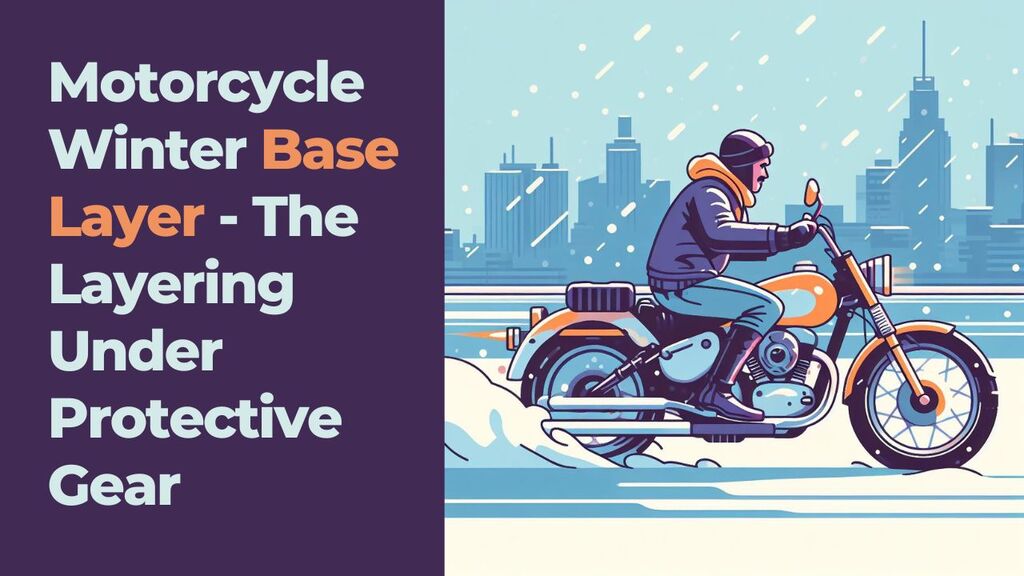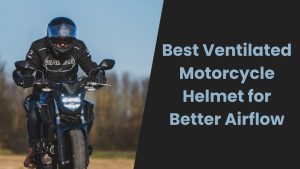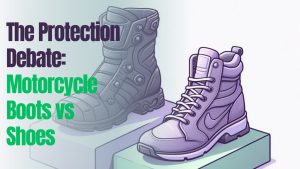As winter draws nearer, many riders will be hitting the roads when temps range from 30 to 40 degrees Fahrenheit. While not frigid, those crisp conditions require more than a thin long-sleeve. You will need the best winter base layer to stay comfortable on rides of 2-3 hours during these colder months.
With so many options, choosing the right one can be confusing. But this guide will break down everything you need to know about motorcycle winter base layers, from choosing the best materials to layering tips for ultimate warmth.
Some of the links in this post are affiliate links, meaning we may get a small commission when you purchase through our links, at no extra cost to you. It helps us covering the expenses of keeping this site free for you. Thank you for your support!
The Best Base Layer Materials for Winter Riding
When it comes to staying warm on a cold winter ride, the materials you choose for your base layers really do make a difference. For us, nothing beats the coziness and temperature regulation of wool.
Here’s a comparison of the most used options as the base layer for cold winter rides:
| Material | Ideal Conditions | Pros | Cons |
|---|---|---|---|
| Merino Wool | * Coldest weather rides (30-40°F) * High-intensity activities * All-day comfort |
+ Excellent warmth-to-weight ratio + Superior moisture wicking + Naturally odor-resistant + Soft and comfortable + Regulates body temperature |
– More expensive – Requires handwashing or delicate cycle – May itch for some people |
| Synthetics (Polyester, Polypropylene) | * Mild to moderate winter weather (40-50°F) * Moderate-intensity activities * Budget-friendly option |
+ Affordable + Dries quickly + Wicks moisture effectively + Many are odor-resistant + Often have compression benefits for improved circulation |
– Not as warm as wool for weight – Can feel clammy or sticky during high exertion – May not be as durable as wool |
| Fleece | * Very cold weather with layering (below 30°F) * Low-intensity activities * Short rides or emergency warmth layer |
+ Very warm and lightweight + Comfortable and soft + Dries relatively fast + Affordable |
– Not as good at wicking moisture as wool or synthetics – Can trap sweat and lead to chills if wet – Bulkier than other options |
1. Wool: A Cut Above the Rest
Wool has always been our go-to for long days in the saddle when the mercury dips. And for good reason! Unlike cotton which can trap sweat and lose its insulation when wet, wool continues to keep you warm even if you start sweating or it gets rained on.
The crimped structure of the fibers makes wool great at wicking moisture away from your skin while also trapping in warm pockets of insulating air.
And don’t let its rep as itchy discourage you – modern wool base layers are buttery soft and comfortable to wear all day long.
We simply haven’t found a better natural material for regulating body temperature on a motorcycle when the weather turns cold and blustery. No matter how briskly the wind blows, a good merino wool base layer will keep you toasty.
FUN FACT: At a speed of 60 mph, the wind chill can make the temperature feel 20 to 30 degrees colder than the actual air temperature, making effective base layers crucial for winter riders.
Cozy Merino: Our Top Choice
Within the wool family, we especially love merino wool for its extraordinary breathability and skin-friendly qualities. The ultra-fine fibers feel light as a feather on yet pack impressive insulation considering their weight.
It’s easy to forget you have a merino wool top or bottoms on since they breathe with your movements instead of leaving you sticky or overheated like some synthetics can.
The natural odor and bacteria resistance is another big perk for us riders who may not change clothes at destination.
Mens 100% Merino Wool Long Sleeve Thermal Shirts

Mens Bottom Pants 100% Merino Wool Thermal Underwear Long Johns Light

For bottoms, it’s hard to beat some long legged Merino socks from Point6. You can get them from Amazon too. Nothing like sealing in heat around the ankles to battle the gusts. We also love their midweight boxers on the colder long hauls.
While a good merino base layer costs a bit more up front, they last for years with proper care. Worth it for keeping comfortably warm, dry and snag-free all winter long no matter the conditions we ride through.
DID YOU KNOW? Merino wool and synthetic thermal materials like polyester, polypropylene and capilene work best as base layers for riding between 30-40 degrees F. They wick moisture and retain warmth even when wet.
2. Synthetic Options
While nothing quite compares to wool, we’ve found some synthetic options can work well too for winter layering. Polyester in particular has come a long way.
Back in the day, those of us who remembered the itchy polyester of years past were skeptical. But modern poly base layers are soft, breathable, and quick drying – almost like wearing nothing at all!
They’re also more resistant to odor than some natural fibers. This can be a big plus if you don’t have time to shower and change before heading back out. The synthetic material just doesn’t hold smells like natural fabrics tend to.
Water also beads up and rolls right off a good poly top or bottoms. This DWR “durable water repellent” coating means you stay drier, which as anyone who’s ridden in the cold and wet knows, makes a huge difference in comfort.
And for the price, poly can’t be beat. The affordability makes them a sensible option for spare layers to stash in your riding gear.
For synthetic base layer options, compression gear made from polyester has served us exceptionally well over the years. The close-fitting material does an excellent job of wicking moisture and trapping warm air.
Running layers from Under Armour have been real MVPs in our collection. Their ColdGear line offers top-to-toe coverage to really lock heat in. We love the snug fit of their tops and bottoms for riding all winter long.
From long rides to short commutes, the UA fabric never loses its stretch or leaves us feeling stiff and bound up like some compression fabrics can. It just moves with us smoothly throughout the day.
DID YOU KNOW? Compression technology in base layers can improve blood circulation by up to 30%, which is vital for warmth and comfort during long rides.
For tops especially, we find their Crew neck style stays put better than V-necks, which can slip around more on the bike. The half-zip varieties also allow for easier ventilation when temps rise mid-ride.
In really frigid conditions, combining a ColdGear base layer with a midweight fleece such as the UA Rival Fleece works wonders too. The extra loft traps reservoirs of insulating air between the layers.
3. Fleece Base Layer
Fleece is another good synthetic choice if you run on the warmer side. Its fuzzy fibers loft to create pockets of insulating air – almost like wearing a lightweight down jacket.
Thermajohn Long Johns Thermal Underwear for Men

Fleece tops in particular can be nice for throwing on over just a t-shirt as an extra layer if temps drop unexpectedly. They compact small too, so don’t take up much space in a saddlebag.
So while nothing quite matches wool’s coziness, don’t rule out synthetics and fleece as effective warmers for chillier months in the saddle. Their practical benefits and ease of care make them worthwhile backups.
4. Cotton Base Layer
While it may be the most common fabric for clothing, cotton isn’t our pick for winter motorcycle base layers. There’s a good reason you won’t find many dedicated riders relying on it when temps dip.
We’ve all had the disappointing experience of getting soaked in the rain on a ride, only to start shivering soon after in our clingy, heavy cotton. The truth is cotton loses almost all insulating ability once wet – not ideal when winter precipitation is inevitable!
It just doesn’t wick moisture like synthetics and wool. Get caught in a shower and within minutes you’ll be left chilled to the bone no matter how many layers sit above it. And drying takes all day versus just an hour or two needed to refresh proper wicking fabrics.
Cotton also seems to hold odors more strongly than other options. Those long, cold rides mean working up a sweat at times too. So when it comes to choosing a layer that will keep its freshness, cotton isn’t the most practical choice.
Now we’re not saying you can never wear cotton riding in winter – just avoid it for the base level touching your skin. Once wet, you’ll be much more prone to misery and distraction caused by the cold. There are far better insulating options out there.
DID YOU KNOW? Many high-tech base layers have antimicrobial properties, reducing odor-causing bacteria by over 90%.
5. Heated Base Layers
For those bitter cold days where even our best Merino wool and polypro layers just aren’t enough, we’ve found heated base layers to be a total game-changer. A bit of an investment for sure, but so worth it when temps plummet.
The Gerbing system has served us riders well over multiple seasons. Their zip-in heated vests and pants boost your core temp without all the bulk of extra layers. Control is as easy as turning a dial.
With a 10 hour battery designed for riding, you can power through even the lengthiest winter commutes toasty warm. An optional lithium upgrade extends that to 16 hours on a charge!
Installation is simple enough that even we mechanics-challenged types can manage. Though an electrician-friend’s help never hurts for the initial install. Well-made neoprene backing on the vest prevents any itch or rub no matter how long you wear it.
Gerbing pads are adjustable too to customize heat levels wherever you need an extra boost, like around the kidneys. Space-age materials keep weight down despite rugged heating elements.
A full system clocks in around a thousand bucks. But consider it the best investment you’ll make toward comfort during sub-freezing rides.
How to Layer Effectively for Riding in Cold Weather
Now that we’ve covered some top base layer materials and specific product picks, it’s important to discuss layering effectively for maximum protection from the elements.
Pairing with Outerwear
Good base layers are useless if you don’t surround them with the right outer gear. We always start with pairing our favorite wool or synthetic shirts and bottoms under a sturdy set of motorcycle pants and jacket.
For us, having Kevlar-reinforced pants and a waterproof, breathable textile jacket on top gives us the protection we need to feel comfortable on longer winter rides. The multiple layers stand strong against road debris and provide a windproof barrier.
BREATHABILITY RATINGS: Advanced base layers come with breathability ratings, with some offering up to 20,000g/m²/24 hours, ensuring moisture control without sacrificing warmth.
It’s key that our base layers fit comfortably under all our protective layers without bunching or being too tight. We want to be able to move freely on the bike without annoying pinches or pulls from tight seams.
Loose and layered is the name of the game for winter riding comfort. And don’t forget about the rest of your extremities – good overboots, gloves and a warm balaclava are musts to complete the protective suit.
Don’t Forget the Extremities
When layering up for a winter ride, it’s easy to focus on the core areas and forget about protecting your hands, neck and feet as well. But as any rider knows, once these extremities get cold, it’s game over for comfort.
A good merino or fleece neck gaiter is indispensable for sealing in neck warmth. We tuck ours up high until only our eyes peer out. Bonus points for models with face mask panels too.
NIKE FLEECE NECK WARMER

Gloves are another priority – our fingers would freeze fast without quality winter gloves. Heated options are awesome if your budget allows. Otherwise, we layer thinner gloves topped with thicker waterproof gauntlets.
And while boots may not seem like a layer, keeping toes toasty is crucial. Ours get an extra kick from insulated socks before slipping into snug waterproof overboots. Toes are the first to freeze without the right protection.
Paying attention to palms, neck and feet makes all the difference on long rides. It’s amazing how much colder the rest of your body feels if any part starts getting nippy.
Finding the Right Balance
When putting together your layering system, it’s important to strike a balance between insulation and breathability. Going overboard on either can compromise your comfort.
For bottoms especially, we’ve found it’s best to have a lightweight Merino or poly base layer, followed by pants with some insulation like fleece-lined canvas.
This prevents overheating from too much insulation right on our skin, while still retaining heat with the fleece layer above. Multiple thin layers work better than one thick bulky one.
Up top, natural fibers like Merino keep their breathability even when multiple layers are combined. But on colder days, we’ll opt for a fuzzy fleece zip-up or vest as a middle layer for added loft without sacrificing ventilation.
It’s also wise to allow for venting. Zippers are wonderful for this! Being able to crack open overlapping layers prevents overheating on the move without exposing skin to elements.
Finding what combos strike the right temperature balance takes some trial and error. But it’s worth experimenting to dial in reliable all-day comfort even in variable conditions. Our motto? Layer for the ride, not the stop.
Outer Layer Options for Cold Weather Riding
Navigating the chilly winds and dropping temperatures requires a strategic choice in outer layers for cold weather riding. The right outerwear not only shields against the elements but also ensures comfort and flexibility.
i. Blocking Out the Wind
Of all our outer layers, nothing makes or breaks a winter ride like a good windproof jacket and pants. Allowing any breeze to penetrate can transform an enjoyable ride into a chilly ordeal real fast.
For us, this means textile riding gear with a securely zipped membrane like Gore-Tex or equivalent. Such breathable membranes stand up fiercely to freezing gusts while still allowing vapor to escape from within.
A wind-cheating jacket paired with matching pants forms the indispensable shell around our insulating base and mid-layers. Loose cuts with long tails and high neck coverage seal drafts better than form-fitting styles too.
Columbia Men’s Glennaker Rain Jacket

We’re particularly fond of casual riding brands like Klim or Rev’It for their combined windproofing and armor. The protection gives us peace of mind should temperatures force an impromptu sliding stop!
Don’t skimp on fit either – nothing spoils comfort like flapping pant hems or jacket cuffs that fail to securely Velcro beneath outer gloves and boots. Snug is key to blocking any vulnerable skin exposure.
DID YOU KNOW? High-quality base layers can wick away moisture 50% faster than cotton, keeping riders dry and comfortable in cold conditions.
2. Relying on Gore-Tex
While several membrane technologies exist, we’ve had the best reliability turning back snow and rain with Gore-Tex outer gear over the years. The brand is legendary among winter riders for a reason.
Their ePTFE membrane seals out liquid elements with military-grade effectiveness, while still allowing vapor to breathe out from within steadily for hours. This prevents the unhealthy dampness that sink other materials when activity level rises.
A good Gore-Tex riding jacket and pants set the gold standard as the reliable last line of defense during messy days. Precise welding creates tanks that just laugh off downpours for the duration.
What’s more, proper Gore-Tex stays fully functional even after multiple washes. Some membranes weaken with each trip through the machine, but ours retain their waterproofing like new season after season.
The comfort of remaining bone dry regardless of conditions outweighs their slightly higher cost compared to some competitors. For us seasoned wintertime riders, they’re an indispensable staple of the year-round gear stable.
3. Choosing Dedicated Winter Outfits
While it may be tempting to make do with 3-season riding gear come winter, we’ve found customized cold weather rigs really make the ride. Manufacturers produce top-notch options precisely tailored to frigid temps.
Touring-specific brands like Klim create specialized pants and jackets engineered from the ground up for demanding sub-freezing journeys. Reinforced seams, extended cuts and premium fabrics shine in brutal conditions.
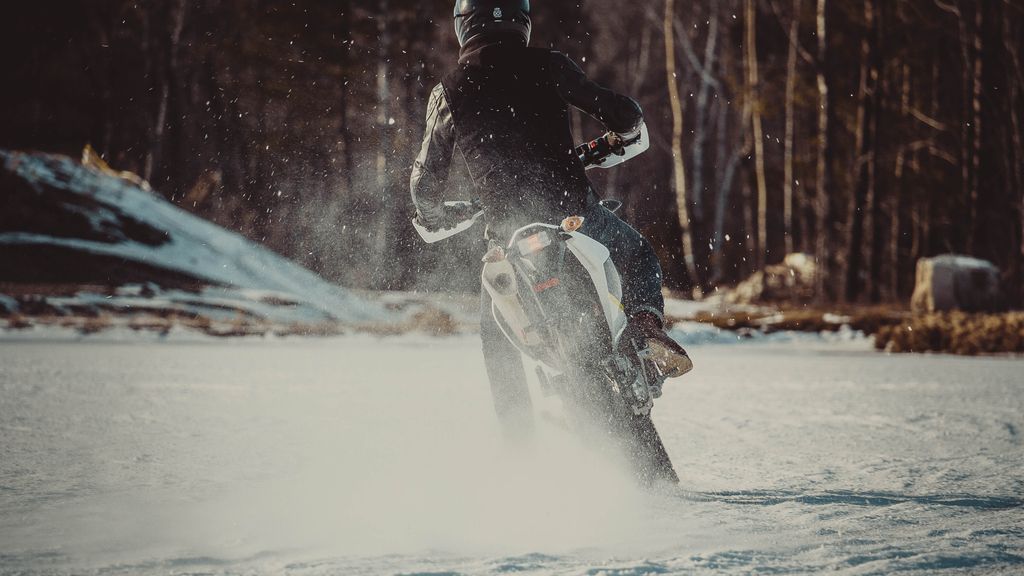
Cozy details like fleece-lined pockets and throat-sealing neck gaiters make a tremendous difference preventing exposure on lengthy hauls. Thoughtful features feed into an overall hardier outfit.
We love how our Klim gear safely shrugs off road grime, never loses traction on salted roads and dries in half the time of lesser kits. The peace of mind inspires riding in colder comfort.
Winter tires and modified routes also help combat slipperiness, but having a high-performing dedicated cold outfit makes facing icy days so much more enjoyable.
How to Ensure Extended Riding Comfort in Winter
Winter riding demands careful consideration of comfort to extend your enjoyment on the road. Here are essential tips and gear recommendations to keep you warm, dry, and cozy during chilly rides.
A Clear View of the Road
One of the most frustrating parts of winter layering is dealing with fogged up face shields, goggles or balaclavas. But we’ve discovered some tricks to keep our view crystal clear even on long rides.
Anti-fog sprays and wipes containing silicones are surprisingly effective. We coat our visors thoroughly before each ride and wipe down any condensation that starts to form mid-journey.
Buff-style neck gaiters cut from merino wool stay magically fog-free, likely due to natural lanolin oils. Their balaclava-like tops seal warmth but never steam over.
As a last resort, calmly peeling down our masks for a moment to air out the moisture often does the trick. It’s all about creating that small air flow.
Using Heated Accessories
Some of our favorite riding upgrades beyond clothing have been heated accessories like gloves and socks. On truly frigid days, supplementing our layers with built-in battery power takes comfort to a toasty new level.
Heated gloves have been a game changer for us. The battery-powered heating elements woven discreetly into the palms and fingers keep blood circulating perfectly. No more numb fingertips even in bitter single digits!
For rides over an hour, the rechargeable lithium batteries provide steady warmth the whole way. We just wear them like regular gloves and forget the cold. An optional twin-pack doubles runtime too.
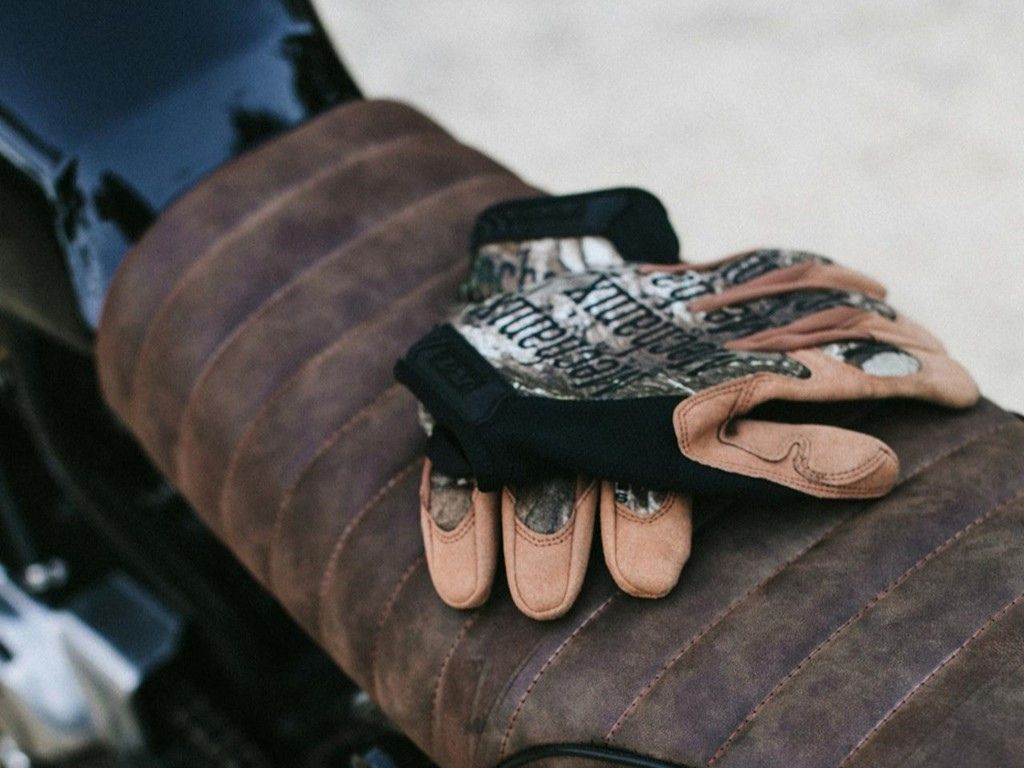
Point6 makes phenomenal battery-boosted socks fitted with microclimate tech as well. Those miracle fibers trap heat generated discreetly along the instep and ankles.
Toes feel snug and cozy all winter long rather than exposed in regular socks. The batteries give our feet toasty bliss for hours on end.
PRO TIP: The neck, hands and feet are common places riders forget to insulate, so garments like balaclavas, gloves and insulated boots/socks are important.
Preparing for Stops
Part of being equipped for long winter rides means planning for stops along the way. We like to pack extra layers in our riding gear so we can adjust as temp needs.
Under our jackets, we cinch bungee cords to secure cargo nets brimming with extra merino buffs, wool socks, and our puffiest vest. It all stows neatly out of sight and reach.
Tank bags and topboxes take our changes of gloves, base layers, socks and neck gaiters. On extended tours, a small dry bag caches our layers for swapping at each destination.
Being able to peel off over-pants or a jacket and pull on fresh, dry base layers makes such a difference getting comfortable at coffee stops and fueling up. It feels heavenly swapping out damp layers!
Some stops have gender-neutral facilities too, allowing full changes in lots. We always stash toothbrush, deodorant, and travel-size clothesline for drying out damper layers before repacking.
Conclusion
Ready to pick the perfect winter base layer? We’ve covered the key materials (wool for ultimate warmth, synthetics for affordability and quick drying, and fleece for extra coziness) to help you choose the perfect match for your riding conditions and preferences. Remember, layering is key for optimal comfort.
FAQs About Motorcycle Winter Base Layer
How do I know if I’m wearing the right number of layers?
You should feel slightly cool when stationary but not cold. Blood flow to extremities shouldn’t be restricted. Add/remove layers as needed based on activity level and conditions.
What’s the best way to store layers while riding?
Use luggage with weatherproof zippers/flaps, bungees or nets to neatly stow extra clothing. Dry bags prevent moisture. Public lockers allow full changes at destinations.
How often should motorcycle winter base layers be washed?
Natural fibers like merino wool can be washed after 5-10 wears while still effective. Synthetic fabrics last longer, around 20 wears, before body oils decrease performance.
What should I do if layers get wet from rain or snow?
Change immediately to avoid losing insulation value from damp fabrics. Bring extra clothes. Wool and synthetics dry fast, but store damp layers in a dry bag or linen until fully dried.
Is there any budget clothing option for winter riding?
Look for affordable workout gear from Target, Walmart, etc. Fleece and polyester work well. Focus spending on outer windproof layer and accessories like quality gloves vs multiple base layers. Layer what you have.

